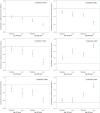Influence of lung function on macro- and micro-structural brain changes in mid- and late-life
- PMID: 39869397
- PMCID: PMC12372754
- DOI: 10.1097/JS9.0000000000002228
Influence of lung function on macro- and micro-structural brain changes in mid- and late-life
Abstract
Introduction: Lung function has been associated with cognitive decline and dementia, but the extent to which lung function impacts brain structural changes remains unclear. We aimed to investigate the association of lung function with structural macro- and micro-brain changes across mid- and late-life.
Methods: The study included a total of 37 164 neurologic disorder-free participants aged 40-70 years from the UK Biobank, who underwent brain MRI scans 9 years after baseline. After 2.5 years, a subsample (n = 3895) underwent a second MRI scan. Lung function was assessed using a composite score based on forced expiratory volume in 1 second, forced vital capacity, and peak expiratory flow, and divided into tertiles (i.e., low, moderate, and high). Structural brain volumes (including total brain, gray matter, white matter, hippocampus, and white matter hyperintensities) and diffusion markers (fractional anisotropy [FA] and mean diffusivity [MD]) were assessed. Data were analyzed using linear regression and mixed-effects models.
Results: Compared to high lung function, low lung function was associated with smaller total brain, gray matter, white matter, and hippocampal volume, as well as lower white matter integrity. Over the 2.5-year follow-up, low lung function was associated with reduced white matter and hippocampal volume, reduced FA, and increased white matter hyperintensity volume and MD. After stratification by age, the associations remained significant among adults aged 40-60 years and 60+ years.
Conclusion: Low lung function is associated with macro- and micro-structural brain changes involving both neurodegenerative and vascular pathologies. This association is significant in both mid- and late-life.
Copyright © 2025 The Author(s). Published by Wolters Kluwer Health, Inc.
Conflict of interest statement
The authors declare that they have no competing interests.
Figures


References
-
- Young RP, Hopkins R, Eaton TE. Forced expiratory volume in one second: not just a lung function test but a marker of premature death from all causes. Eur Respir J 2007;30:616-22. - PubMed
-
- Janssens JP, Pache JC, Nicod LP. Physiological changes in respiratory function associated with ageing. Eur Respir J 1999;13:197-205. - PubMed
-
- Brusasco V, Warner DO, Beck KC, Rodarte JR, Rehder K. Partitioning of pulmonary resistance in dogs: effect of tidal volume and frequency. J Appl Physiol (1985) 1989;66:1190-96. - PubMed
MeSH terms
Grants and funding
LinkOut - more resources
Full Text Sources

